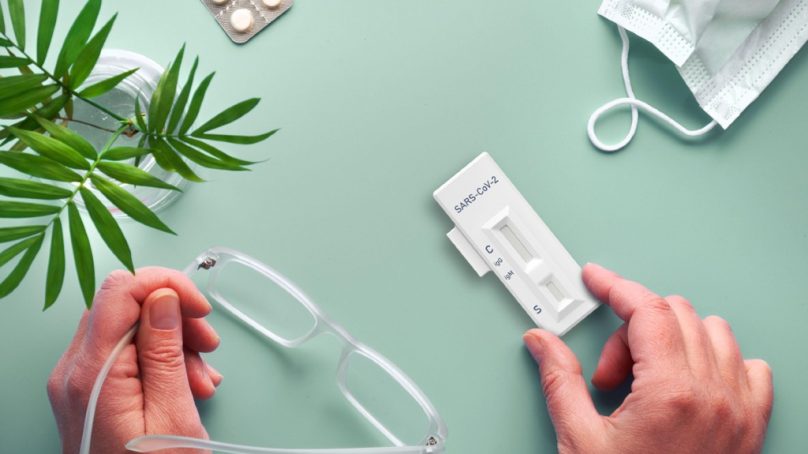
The imminent large-scale rollout of rapid coronavirus tests promises to aid public health responses to Covid-19 — but a rapid home test remains elusive.
New SARS-CoV-2 rapid tests, which can deliver results in a matter of minutes in the field rather than taking days in clinical diagnostic laboratories, are starting to become widely available.
They are based on a variety of technologies and formats, both old and new: conventional antigen-based tests for detecting viral proteins; polymerase chain reaction (PCR) assays for detecting viral genomic material; and newer CRISPR-based diagnostic tests, which also detect viral genomes but in fewer steps and dispensing with PCR machines.
Rapid tests are easy to use: they can be deployed in high-risk environments, such as care homes or educational institutions, and by personnel with little or no specialist training. Some will be suitable for home use as well, once given the go-ahead by regulators.
Collectively, they promise to be a useful adjunct to lab-based PCR diagnostic testing and, if deployed effectively and at scale, could strengthen flagging containment efforts by quickly identifying new outbreaks before they spread.
The need is urgent. In recent weeks, numbers of confirmed cases have started to climb sharply in many countries. Apart from a handful of states that have curbed the spread of the SARS-CoV-2 virus, the rising numbers point to the widespread failure of efforts to contain the virus.
Inadequate test-and-trace systems and insufficient compliance with recommended safety measures have allowed the virus to continue to propagate widely. Fast and simple-to-use tests could help push back against the virus, particularly in high-risk settings, where outbreaks can quickly spiral out of control.
Sherlock Biosciences, which earlier this year gained the first ever US Food and Drug Administration (FDA) Emergency Use Authorisation (EUA) for a lab-based CRISPR test, is extending the technology into point-of-care settings, such as nursing homes.
It is pursuing this in collaboration with Trowbridge, UK-based Binx Health, a producer of automated desktop instruments that normally run rapid PCR tests. Their joint offering combines Sherlock’s CRISPR test with Binx’s analyser.
Sherlock’s assay detects SARS-CoV-2 RNA by a guide RNA that activates a Cas13 enzyme, which then cleaves a reporter sequence linked to an electrochemical label. The label is then oxidised at an electrode, where it generates a measurable current.
“It’s surprising, actually, that you can marry two technologies together so quickly,” says Binx chief technology officer Anna Dixon. “We’re well on the way to submitting our EUA to the FDA.”
CRISPR-based tests also represent a promising option for home testing. Although still an emerging technology, CRISPR-based recognition of the virus is both highly sensitive and specific, which could eliminate much of the uncertainties associated with traditional rapid diagnostics.
Mammoth Biosciences is developing a CRISPR–Cas12-based test in partnership with London-based GlaxoSmithKline.
Although their end goal is a home test, they will focus initially on developing a test for care facilities operating under Clinical Laboratory Improvement Amendments (CLIA) rules first, says co-founder and CEO Trevor Martin.
Sherlock Biosciences is advancing a paper-based CRISPR test for at-home use and for low-resource settings. The test is based on its Inspectr platform, developed by co-founder Jim Collins of the Massachusetts Institute of Technology (MIT).
A quick version of the Sherlock assay known as STOP has been recently reported by three other Sherlock co-founders: Omar Abudayyeh and Jonathan Gootenberg, both of the McGovern Institute at MIT and Feng Zhang of the Broad Institute of MIT and Harvard.
Short for Sherlock Testing in One Pot, the test combines isothermal loop-mediated amplification (LAMP), a thermostable Cas12b enzyme from Alicyclobacillus acidiphilus (able to withstand the high-temperature LAMP amplification step) and a magnetic bead sample purification method.
STOP showed 93.1 per cent sensitivity and 98.5 per cent specificity in tests conducted by an external lab.
“It’s pretty good sensitivity for a point-of-care assay,” Abudayyeh says. The trio aims to get the test on the market next year.
Newly minted 2020 Nobel laureate Jennifer Doudna, of the University of California (UC) Berkeley; Daniel Fletcher, also of UC Berkeley; and Melanie Ott, of the Gladstone Institutes at the University of California San Francisco, have also unveiled a CRISPR-based test. Theirs can be read out on a smartphone.
It avoids the need for nucleic acid amplification, which most other CRISPR-based tests still require, by employing two or more CRISPR RNA (crRNA) molecules to boost the signal generated by Cas13 — which in turn bumps up the collateral cleavage of reporter sequences, once the viral nucleic acids are detected.
“The surprise was that with two guides for SARS-CoV-2 we came into a diagnostic range that was acceptable — not the same range as PCR, but a range we can start to work from,” says Ott.
The test detects 100 viral genomes per microliter in less than 30 minutes. Eliminating the nucleic acid amplification step allows it to give quantitative as well as a qualitative result.
The team introduced another innovative step into the test: they exploited the high-quality optics of modern smartphone cameras to measure the fluorescence generated by the assay. This improves the sensitivity of the readout about tenfold. The group aims to secure an EUA late this year or early in 2021.
PCR tests that detect different regions of the SARS-CoV-2 genome have dominated efforts to track the virus so far. These tests are highly accurate and scalable, but need to be run in centralised labs and require trained personnel and thermocycling machines for rounds of nucleic acid amplification.
This is not practical when countries need to ramp up testing, and even in wealthy regions such services have led to capacity bottlenecks. This has resulted in test shortages and delays in receiving the results, which can complicate contact tracing in the event of a positive result.
In any case, limiting testing to symptomatic individuals is a flawed containment strategy, as people are infectious during the viral incubation period, before symptoms appear. A UK analysis found that 76 per cent of participants in a random survey who tested positive for SARS-CoV-2 had no symptoms. At the other end of the infection cycle, an abundance of caution may result in individuals undergoing extended isolation long after they have ceased to be contagious.
For the next phase of the pandemic, Michael Mina, assistant professor of epidemiology at the Harvard T.H. Chan School of Public Health, and other experts are calling for a more nuanced approach to tracking the virus, which would reflect both the kinetics of infection within an individual and the dynamics of viral spread through a population.
For containment to be effective, those who are contagious need to be identified and isolated in a timely manner, according to modelling work conducted by Mina and colleagues.
A rough and ready surveillance approach, based on frequent, population-scale rapid testing, would, they argue, have a more dramatic impact on curbing the virus than one-off PCR testing of people with suspected cases. Cheap antigen tests, based on the same lateral flow immunoassay (LFA) format used in home pregnancy tests, underpin this strategy.
Although the sensitivity of such antigen-based rapid tests is about two orders of magnitude lower than that of a PCR test (1,000 viral copies per ml for PCR compared with 10,000 copies per ml for LFA), even so, repeated rapid testing of all, they argue, could do a better job at identifying contagious individuals than reliable but cumbersome PCR tests.
Such large-scale rollouts of rapid antigen tests have yet to be deployed. “It’s not really been piloted in a way I would like to see,” says Mina. Several initiatives are getting underway, however. Slovakia recently tested over 3.6 million people — about two-thirds of its population — over a two-day period, and found that over 1 per cent of them were positive.
Non-participants, moreover, were required to quarantine for 10 days. The UK government has selected Liverpool to pilot a mass testing programme involving hundreds of thousands of tests.
Mina is himself advising Bahrain, which is planning to acquire 1.5 million tests, enough to cover its population once. The United States has purchased 150 million BinaxNOW antigen tests from Abbott — barely enough to cover about one week of the kind of intensive surveillance testing Mina advocates.
Low-income countries cannot afford to contemplate such population-wide testing, but are instead looking to quick antigen testing as a core diagnostic strategy. The Bill and Melinda Gates Foundation is part of an international coalition supporting this approach, and it recently entered purchase agreements with Abbott and SD Biosensor of Suwon, Korea, for 120 million tests, priced at a maximum of $5 per unit.
Another coalition member, the Foundation for Innovative New Diagnostics (FIND), a Geneva, Switzerland-based non-profit, will evaluate the tests.
In contrast to antigen tests, rapid tests that pick up on the presence of antibodies are of little value in capturing active infections in an individual, given the lag between the start of an infection and the emergence of a detectable antibody response to it.
Misplaced euphoria fuelled the initial uptake of antibody tests.
“Right from the beginning, many of us were saying they’re not meant for what people were buying them for,” says Ranga Sampath, CSO at FIND.
The market, moreover, was flooded with poor products, which undermined confidence in these tests.
Antigen test developers could face a similar dilemma. Because antigen tests have lower specificity than PCR tests, they can generate high levels of false positives in low-prevalence settings, when a person’s probability of infection and a test’s false positive rate are numerically similar.
“You need to do backup PCR if you test positive with lateral flow assays in asymptomatics,” says Bruce Tromberg, director of the National Institute of Biomedical Imaging and Bioengineering (NIBIB), which is funding the development of innovative tests through a $500-million initiative.
This RADx strategy supports a broad range of technologies: from high-performance LFAs through rapid, low-cost PCR tests that can be conducted directly in care settings to next-generation sequencing and novel tests based on CRISPR recognition.
The programme’s goal is to add 2.7 million tests per day by year’s end. The most recent contract awardees include five companies developing point-of-care tests, several of which will, in time, lead to at-home tests as well.
Tromberg is not opposed to the LFA format but is conscious of its limitations. “It’s not the foundational piece you want to build a high-confidence test program around,” he says.
Over-the-counter Covid-19 tests for home use have yet to emerge. Regulators have historically been slow to approve such tests because of the absence of clinical guidance to help a person interpret the results. In Germany, for example, HIV is the only infectious disease for which an at-home diagnostic kit has been authorised.
Berlin-based Pharmact hopes to change that and has started lobbying regulators and legislators in advance of completing clinical validation so that its SARS-CoV-2 antigen test, BELMONITOR-COV-2, can be used either as a rapid clinical test or at home.
The test samples material from the mouth, nose and throat. The user gargles a solution and transfers it to a small reaction vessel coated with the assay components. Then a shallow swab from the front of the nose is also whisked through this solution to increase the amount of analyte present.
“You have a reaction in a few minutes,” says Pharmact’s medical director, Gunther Burgard. Politicians have, he says, responded to the company’s overtures with “open arms.”
As pressures on populations, health systems and economies start to mount, there is an urgent need for more tools to combat Covid-19 at multiple levels. Even the most optimistic projections suggest that safe and effective vaccines will not be available in meaningful quantities until well into next year.
It is looking increasingly realistic to assume that the virus will continue to circulate in many populations in the meantime. In such a grim scenario, effective rapid tests cannot come quickly enough.
- A Nature magazine report











